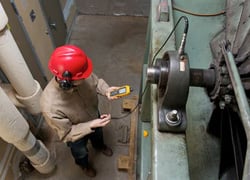Vibration is often a precursor to machine failure, and you can frequently detect it prior to other signs of trouble. Vibration itself is not a problem, but is simply the normal oscillation of a machine and its components. Excess vibration, however, indicates a problem. Signs of trouble that you might detect include changes in heat, sound, or energy consumption. Once a machine displays these signs, it is generally just a matter of time before failure occurs. Fortunately, data gathered from vibration screening make it possible to determine how much time a machine might have left before it fails, enabling you to take the appropriate steps.

Benefits of vibration testing
Vibration screening offers a number of benefits. One of the chief benefits is predictability. The early warning offered by vibration screening means that maintenance staff has adequate time to acquire all parts required for repairs. It also means that the repairs can be scheduled in advance for a convenient time.
Safety is another benefit. If a machine is on the path to failure, it can be taken offline before it deteriorates to the point that it could create a hazard.
Running machines to failure is the smart choice in some instances, but certainly not all. Often, it makes the most sense to keep machines running smoothly with a regular preventive maintenance schedule. This method of maintenance is typically cheaper over the long run, as it allows for the avoidance of overtime and downtime. Regular maintenance and testing allow for better, more accurate budgeting, and decrease the likelihood of a failure that would lead to a production stoppage. Using this method helps to keep the costs associated with repairs in check. Thus, vibration screening can lead to money saved in a number of ways.
Find out more about the benefits of vibration testing
Types of vibration testing
Spectrum analysis offers a detailed, informative look at a machine's condition that can help you to understand the underlying problem, as well as the machine's likely time to failure. This is possible through an analysis of the vibration spectra, or the amplitude of vibration vs. the frequency. Done over time, this method of testing establishes a baseline for the machine and allows for its performance to be tracked.
There are simpler ways of testing vibration, such as using a vibration pen. A vibration pen can determine whether a problem exists by looking at the overall vibration or bearing condition of the machine. The pen sacrifices the sophistication and details of spectrum analysis for ease of use and simplicity. Expert training is not required.
Find out more about mechanical troubleshooting and the family of Fluke vibration tools
A new vibration meter from Fluke
A fast, easy-to-use vibration meter such as the Fluke 805 Vibration Meter measures overall vibration as well as specific variables, like bearing condition and temperature, to provide a more complete picture than a pen. Its combination vibration and force sensor tip compensates for user variance (force or angle), yielding accurate, repeatable readings. Its four-level severity scale and onboard processor calculate bearing condition and overall vibration using easy-to-understand textual alerts (Good, Satisfactory, Unsatisfactory, Unacceptable). Sensor sensitivity can read a wide range of frequencies (10 to 10,000 Hz and 4,000 to 20,000 Hz), covering most machine and component types. Its straightforward user interface minimizes the user inputs to RPM range and equipment type.
The Fluke 805 is a multifunction vibration screening tool with the ability to upload data to a PC to analyze trends and changes over time. You can see abnormalities at a glance, and you can compare all readings to ISO standards. While viewing the data on a PC allows for the best big-picture assessment, you can see prior measurements on the device itself for quick analysis of the condition.
The Fluke 805 uses high frequency (4,000 Hz to 20,000 Hz) to locate bearing faults, and does bearing condition assessment using the cutting-edge Crest Factor Plus (CF+) algorithm. Low frequency (10 Hz to 1,000 Hz) is used to measure overall vibration. Beyond numbered results, the four-level severity scale is available for both bearing and vibration data. This scale makes it possible for maintenance staff to instantly understand the severity of any problems, rather than requiring them to depend on numbered results alone. Further, information about the infrared (IR) temperature offers another glimpse into the machine's overall health and condition.
The design of the Fluke 805 minimizes the potential for user errors; the color-coded lighting, for example, makes it less likely that maintenance staff will use the wrong angle or the wrong amount of pressure when conducting the screening.
Designed with ease of use in mind, the Fluke 805 boasts a user-friendly interface; an accelerometer to access hard-to-reach spots; and audio output in order to listen to bearings.